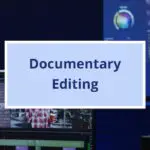What is post production in film? It’s where the editing steps transform film footage into a coherent story.
The making of a film takes more than film footage quickly recorded on camera, no matter how good the storyboard and shot list was.
Instead, a careful workflow, different types of professional software, and a post production team all come together to turn your footage into an absorbing story.
Whether a film production is for a short film, big budget feature film, or a video production for a commercial client, the post-production stage needs people working together to create an editing process that results in a coherent and engaging finished film.
Post-production in film is one of the most critical components of the filmmaking process. It’s where the film truly comes to life and where the visuals and sounds are polished and put together to create a cohesive story.
Before post-production, the footage shot during principal photography is just a bunch of files or actual film, often referred to as raw footage. That’s why post-production is fundamental to the process of filmmaking.
Post-production is the phase of filmmaking where all the pieces of the puzzle are put into place.
It involves a large number of skilled professionals, including editors, sound engineers, foley artists, colorists, and others. Each of these experts contributes to creating a successful film.
The post-production process includes multiple components, including picture editing, sound editing, music production, sound mixing, and others. These are separate stages that require specific skills and expertise.
Collaboration across specialists working remotely is useful, but being in the same space is essential for providing nuanced and specific notes to the final result.
Data and Asset Management
One of the first steps in post-production is prioritising the safety of your footage.
This involves dependable storage to keep all the footage secure and safe, transferring all the raw footage into a secure storage system.
Raw footage takes up a lot of space, so invest in the proper storage and backup systems.
Editors use powerful RAID systems that improve the performance and reliability of standard data storage.
Centralised storage allows files to be accessed by multiple people at the same time while maintaining speed. The most popular centralised storage system used by post production houses is called a San (Storage area network).
NordVPN protects data when travelling and working remotely.
Understanding Raw Footage
Before diving into editing, familiarise yourself with your raw footage. It may be overwhelming at first, but it’s important to know what you’re working with.
If you shot with multiple cameras, sort and categorise the footage based on the camera used. This will make it easier to find the shots you need.
Editing Raw Footage
Editing raw footage by selecting the best shots, arranging them in a particular order, and adding music and sound effects to support the visuals, creates a cohesive story with an understandable narrative. It’s where the film takes shape, even though the first version of the film is a rough draft.
Stringing together individual shots filmed during principal photography takes creative and storytelling skills, combined with patience and organisation. Investing in professional editing software can make the editing process smoother and more efficient.
Not all footage will make it into the final product. Choose the shots that are most effective and impactful for the story. Have a clear idea of what you want the final product to look and feel like. This will make the editing process smoother and more focused.
Trim each clip down to only the essential parts. This will keep the audience engaged and prevent any unnecessary drag in the story.
Each scene should have an objective or purpose. Use editing to reinforce that objective by emphasizing certain shots or angles.
To make your edits flow smoothly, add movement to each cut to make it look seamless.
During this part of the post production stage, you can change the appearance of some shots using video editing software and plugins.
Say, for example, you needed a more handheld feel, you could use Red Giant’s Universe plugin called Camera Shake. You can also use a plugin that allows for adjustment of frequency and amplitude of movement, an automatic tiling feature that prevents images from going off-screen, and Motion Blur can be turned on and matched to camera settings.
VFX Effects
During this stage, the VFX team will add special effects, create 3D animation, and perform any necessary compositing to fully realize the director’s vision.
DPX, Open, EXR, or TIFF file formats are commonly used for exporting and importing image sequences in visual effects.
Obviously, not all films need visual effects. For some, the detailed process that involves many more people and days is simply too expensive, so cheaper alternatives are worked through at the principal photography stage, with careful editing of the footage in a way that doesn’t reveal the budget solution.
Sound Editing
Editing is followed by sound editing, where sound engineers perfect the audio tracks, remove background noise, re-create sound effects, and add voiceovers where necessary.
The music production also takes place in this stage and often involves the creation of an original soundtrack for the film.
During the sound editing stage, the sound editor will mix and add all of the necessary sound effects, music, and dialogue to the final cut.
The sound editor has to maintain the timeline and ensure that everything syncs perfectly. Sound effects can be pulled from a library or created by the foley artist.
Some dialog, or dialogue, may have to be re-recorded. The audio may also require dolby atmos.
Pro Tools is the standard application for audio in the cinema industry.
Sound mixing combines all the different sounds and tracks to create a complex and cohesive sound. It’s where everything comes together, and it’s an exciting and magical part of the post-production process.
Audio is just as important as the images. The post-production team, which may include a sound editor, foley mixer, composer, ensures audio is consistent throughout the entire film.
Color Correction/Colour Correction
Color correction uses color balance. Color balance is essentially an extension of white balance.
You use color correction to fix colour imbalances for your production, as well as issues of exposure and contrast.
Once you have completed color correction, you move on to color grading, which is the more stylistic color aspect of your film, creating the overall mood of the images.
Color Grading/Colour Grading
Color grading, or colour grading, involves adjusting the colors, contrast, and tone in the footage and making it consistent throughout the entire movie.
Raw footage may look dull and flat due to the lack of color grading during shooting. Add color correction to bring vibrancy and life to your shots.
It’s achieved with professional software, such as Magic Bullet Looks.
If coloring for a theatrical production, the DCI P three color space is used and deliverables may be in Rec 709 or Rec 2020.
Color grading comes after editing, so after VFX and sound effects have been added.
Mastering and delivery
The final stage of the editing and post production process involves creating a final master of the film in the desired format and delivering it to the appropriate channels for distribution.
Compressing a project file slightly reduces its quality.
Final files may include multiple channels for multiple theaters or cinemas.
Post Production Team
The post production team depends on the budget, requirements of the finished product, skills and interests of the people involved, and other individual factors.
There’s usually someone acting as a Post Production Supervisor, even if they don’t have that title, because this is a process that involves many different specialisms and fundamental stages.
So the workflow needs to consider not just the professionals and software processes, but also communication systems.
Frame IO is a crucial and highly recommended app for postproduction, allowing frame specific feedback for the production team. The app allows for the organisation and clarity of files during editing. Designed for use by both freelancers and studios Frame IO integrates with the most commonly used editors including Premiere Pro and Final Cut Pro.
My Post-Production Process: Film Riot/YouTube
This episode of Film Riot dives deep into the post-production process for the film ‘Ballistic.’ Includes discussion on the use of various plugins, including a customizable one for adjusting frequency and amplitude, and a Camera Shake plugin for adding a handheld feel. It also explores the value of apps like Frame IO for organizing files during editing, and VPNs like NordVPN for protecting data when working remotely. Learn about the collaboration process between the filmmaker, colorist and composer, giving us insight into how the final product was achieved.
Post Production in Film
In conclusion, post-production in film is an essential and critical part of the filmmaking process.
It’s where the film truly comes to life, and several skilled professionals collaborate to create a successful film.
This is also a time-consuming process where the stages of post production require specialist people and software, but it’s worth it when you see the final product on the big screen.
More about Filmmaking
- Low Budget Filmmaking: More for Less
- Lighting Department Film Roles
- Shooting An Interview
- Documentary Editing
- What is Sound Design in Film?
- Color Grading for Documentary Series or Film
- Film Set Etiquette: Professional Behaviour on Set
- Observational Documentaries And Their Impact
- Essential Skills for Film Industry Professionals
- How to Create a Storyboard in 6 Simple Steps
- What Makes a Film Successful
- Breaking into the Film Industry without Experience
- Sports Documentary Filmmaking
- How to Create a Storyboard Using Sticky Notes
- Remove Background Noise From Video
- Why Do Filmmakers Use Clapper Boards?
- Indie Films
- Indie Filmmaking
- What is Post Production in Film
- Ken Burns Effect: Creating Eye-Catching Sequences






















